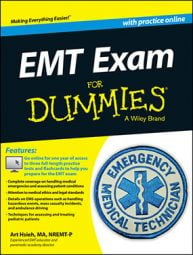When you go to take the EMT exam, make sure you know how to manage trauma. After you review various mechanisms of injury and the critical injuries they can cause, take a look at the following plan of action that can be used for any trauma patient:
Ensure that the scene is as safe as possible before entry and wear appropriate personal protective equipment.
Evaluate the scene for signs of the mechanism of injury.
Look at the patient’s appearance and position as you approach.
If indicated, manually stabilize the cervical spine while you evaluate for airway patency, breathing, and circulation (you guessed it — the ABCs).
Ventilate the patient if needed, right away.
If there is major external bleeding, stop it.
If there is an open wound to the neck or chest area, block it with your gloved hand or immediately apply an occlusive dressing.
If the patient appears in shock, lay the patient supine.
You may have to do some of these steps almost simultaneously. Other rescuers can help.
Rapidly assess the head, neck, chest, abdomen, and pelvis for injuries.
If the patient has an actual or potential serious injury, package and begin transport to a trauma center.
If you determine that the patient’s injuries are not life- or limb-threatening, perform a detailed exam and appropriately manage all injuries prior to transport. This may include splinting extremities, bandaging all wounds, or applying ice packs to sprains or strains.
While enroute, provide supplemental oxygen, obtain a set of vital signs, and note the patient’s medical history, medications, and allergies.
If time permits, perform a detailed, head-to-toe examination looking for minor injuries. If possible, bandage other wounds and splint possible extremity fractures.
Fractures can cause a lot of pain and splinting may help.
Constantly reassess the ABCs.
They can change quickly if the patient is bleeding internally or is hypoventilating.
Some exam questions check to make sure you have an organized, logical approach to trauma care. Respond to the following example.
A construction worker is caught by the blast of a small, exploding propane tank and thrown 10 feet, landing on his back. He is confused, has difficulty breathing, and has cool, pale, and diaphoretic skin. He has second- and third-degree burns to his arms, anterior chest, and abdomen. He has clear lung sounds.
You see multiple lacerations across his face and neck. His pulse rate is 130, and he is breathing 20 times per minute. You should
(A)sit him up, administer supplemental oxygen, begin transport, and dress the burn wounds.
(B)perform spinal immobilization, dress the burn wounds, and begin transport.
(C)perform spinal immobilization, administer supplemental oxygen, begin transport, and dress the burn wounds.
(D)keep the patient supine, administer supplemental oxygen, dress the burn wounds, and begin transport.
The correct answer is Choice (C). This patient is critically injured, with altered mental status and signs of shock (such as poor skins signs and tachycardia). Immediate transport is warranted; perform the minimum level of care on-scene.
In this scenario, spinal immobilization and supplemental oxygen should be provided prior to transport, ruling out Choices (A), (B), and (D). Although the burns are serious, their effects on the body won’t occur until much later in the process. You can delay treating them until after transport has begun.

